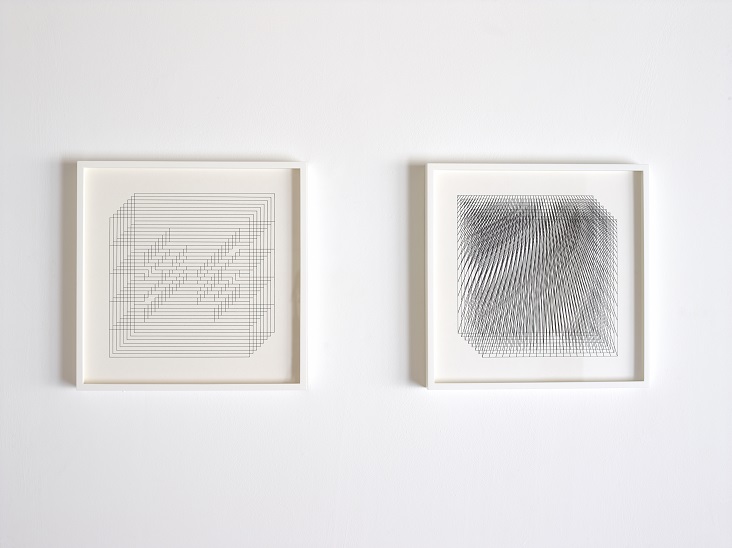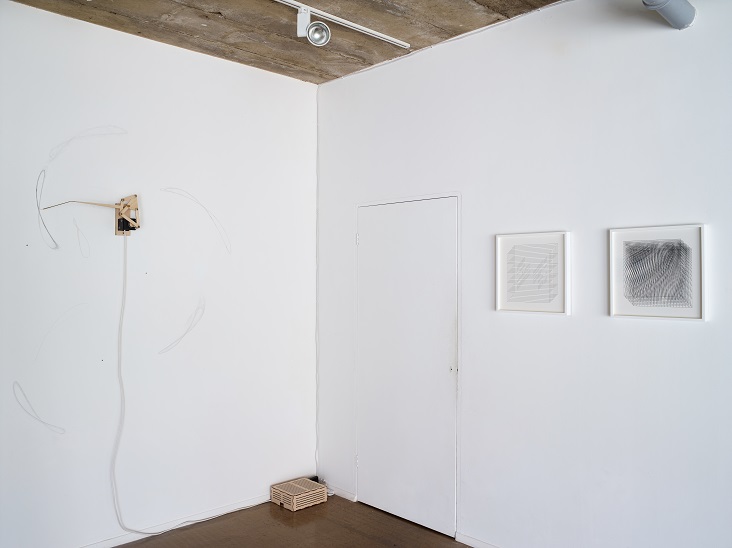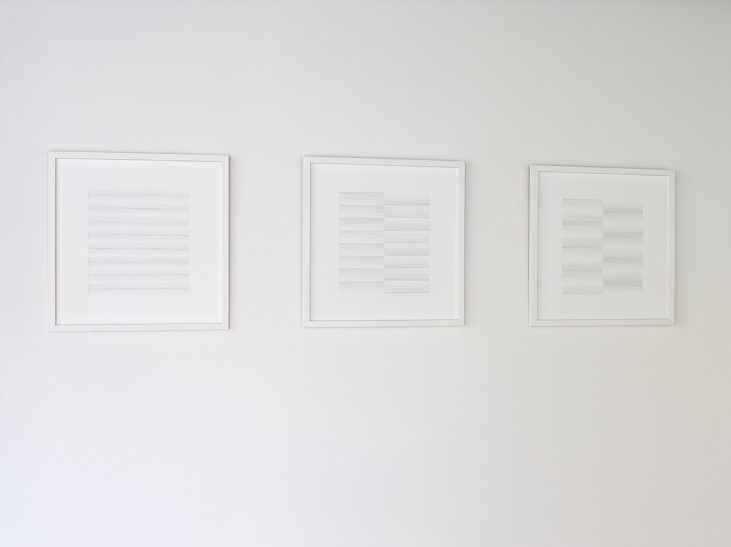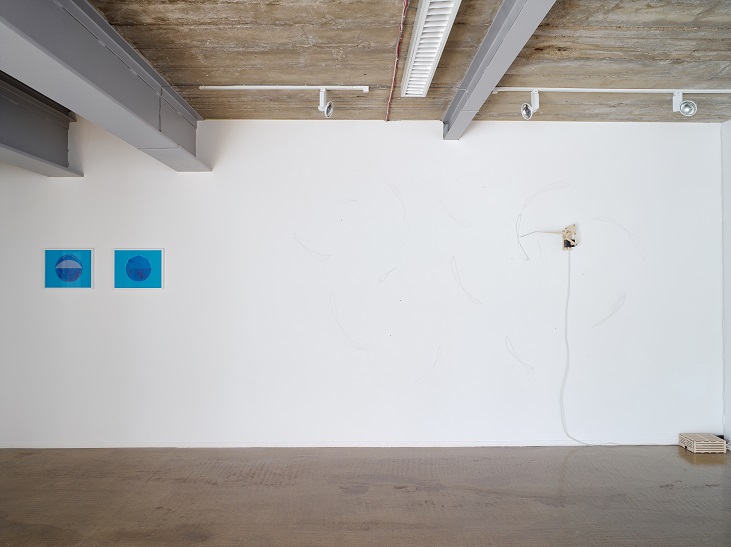The curatorial and editorial project for systems, non-
8 Lines
Platform A Gallery, Middlesbrough, 20 June -
A review by Alan Hathaway
©Copyright Patrick Morrissey and Clive Hancock All rights reserved.
‘What does it mean for architects to return to pen and paper, because the relationship between thought and action is somehow interfered with when computer programs are employed’? Avis Newman and Catherine de Zegher in conversation, The Stage of Drawing, Gesture and Act (2003)
Installation shot
In recent years we have seen drawing repositioned as a primary means of expression,
whilst continuing its role as a vital exploratory tool. Drawing is said to have embraced
ideas and forms banished under late modernist/formalist ideology: appropriation,
myth and narrative, political and personal histories. It has been pushed (like painting
and sculpture) so as to become a non-
Aside from the now extensive theoretical frameworks for drawing and its variety of potential applications, at a very fundamental level we do seem to be very interested in the way people continue to make marks on surfaces.
All the artists in the exhibition 8 LINES make marks on surfaces: they all make drawings.
The presence of systems in art and in life are an ongoing preoccupation in the individual and collaborative practices of Patrick Morrissey and Hanz Hancock, the curators of this show and the directors of Saturation Point UK.
For this exhibition they asked eight artists (themselves included) to respond through drawing to the ‘figurative, notional, mathematical, geometric and cultural signifiers of the number 8, this being the atomic number of oxygen, the bits in a byte, the primary planets in our solar system and the verticals in a cube...’
(8 LINES exhibition catalogue).
Richard Serra’s assertion in the exhibition catalogue: that drawing is a verb rather than a noun, is key to understanding Morrissey and Hancock’s desire for the artists to examine and consider the generative capacity of drawing within their respective practices.
Although the artists selected have diverse approaches to drawing: planning, mapping,
thinking, intervening, marking and executing, on first inspection there seem to be
more formal similarities than differences between them. This is no bad thing and
gives the exhibition a definite coherence. The hang is relatively sparse, which is
not surprising given the pedigree of both Saturation Point and Platform A. The work
is predominantly wall-

Installation shot
Mary Yacoob is, I believe, only the second artist to use the large glass windows
at Platform A as a surface on which to work directly. Her impressive large-
Peering out through these vinyl marks we see familiar street furniture: a bright yellow grit bin, terrifying attempts at municipal planting, temporary billboards and signage, along with a multitude of painted lines and symbols which organise, instruct and segregate the users of this shared space.

Mary Yacoob Octagon (2019), vinyl, window installation
Back in the gallery on the far wall, these lines and colours are echoed in Morrissey
and Hancock’s Tracery, a bright yellow painted panel, its object quality emphasised
by the cut-
Morrissey & Hancock, Tracery (TQID series), pen on panel, 2019
My relationship to the exterior space is similarly heightened by Rachael Clewlow’s
diary work, Notebook 2014, which is placed sculpturally on the gallery window ledge
in a small vitrine. This work is part of an ongoing series, begun in 2003, in which
tiny hand-

Rachael Clewlow, Notebook installation (2011)
Opposite the window are Ben Gooding’s two large drawings on canvas, Invariant Formation no III and IV. From a distance one seems to resemble an aerial drawing of a city, the other a kind of mutated Spirograph. I see loops and circles (the number 8?) come and go in a tangle of lines. There is, I read in the catalogue, a system at play, one that allows ultimately for any logic to be disrupted, for the mark to be made. I struggle with written explanations or instructions, I need to be shown, I am an observational learner. I do, however, get the general idea enough to enjoy the order and chaos present within these works.
Ben Gooding, Invarient Formation 111 & 1V, graphite on canvas (2012)
At the other end of the gallery Francesca Simon’s Discovery Bay 1 and 2 provide a welcome injection of colour, the stunning aquamarine blue in both pieces providing a counterpoint to the yellow in Morrissey and Hancock’s Tracery. Like Yacoob’s work, these drawings are a synthesis of geometry and place. Simon recently visited Jamaica Bay where she encountered a large rusting dome, an industrial remnant of the Kaiser Bauxite works. Her drawings are like two blue jewels, fusing this experience with both pure circle and octagon.

Francesca Simon, Discovery Bay 2, vinyl, pigment, pen on paper (2019)
Adjacent to these works Duncan Bullen’s drawings Greyscale 001, 002 and 0005 employ
a simple and highly effective system, which I was able to get to grips with even
without a written explanation. Although he uses print and digital technologies in
his wider practice, for this show he chose to use the tonal scale of 8 Faber Castell
Polychromos pencils (black, white and six cold greys 1-

Duncan Bullen, Greyscale 001, 002, pencil on paper (2019)
Wendy Smith’s Octet (study 1) and Octet (study 2) sit on the opposite wall. Both
are based on what she describes as “a deceptively simple underlying square”, the
relative sparseness of the first piece contrasting with the density of the second.
Smith’s practice is based entirely within drawing, and in these rigorous and tough
works she addresses directly the notion of investigation rather than expression.
The emphases that she places on them are hand-

Wendy Smith, Octet 1 & 2, pen on paper (2019)
Of all the artists in the show, Kennedy has perhaps gone to the most trouble, or
the greatest lengths, to distance himself physically from the marks ‘he’ creates.
A wall-
‘Do it again and again and again, do it again and again and again.’ Joy Division, Glass (1978)

Nick Kennedy, Truth Plotter 12, mixed media, installation/drawing (2019)
The gallery is quiet during my visit and there is a an alternating high -

Installation shot
8 LINES is a fascinating exploration of both drawing systems and gestures.
In a transcribed conversation from 2003, Avis Newman and Catherine de Zegher highlight the fact that many architects have returned to the direct contact of pen on paper, cutting out the computer in order to avoid unwanted mediation between thought and action. Ultimately, the role of drawing for the artists in 8 LINES seems very different to this preliminary, spontaneous, autographic, ‘thinking things through’ approach. Their drawings are the result of systems, strategies, material processes and machines that generate or ‘allow’ that gesture to exist.
As such they seem to owe a great deal to the conceptual and experimental approaches
to drawing that accompanied the sculptural practices of the 1960s and 1970s. Maybe
what distinguishes the drawings in this show from process drawing per se is the desire
of the artist to remain present; the work doesn’t simply ‘make itself’’ and maybe
within this terrain there exists the potential for more intimate, sometimes ‘un-
‘Between thought and expression, there lies a lifetime’, Some Kinda Love, The Velvet Underground (1969)

Installation shot
Travelling back to Newcastle from Middlesbrough by train, I began to think about the largely hidden computerised systems of signals, ticketing, timetables and personnel rotas that all coexist in order to get me back safely, but not, it has to be said, in good time or in much style.


